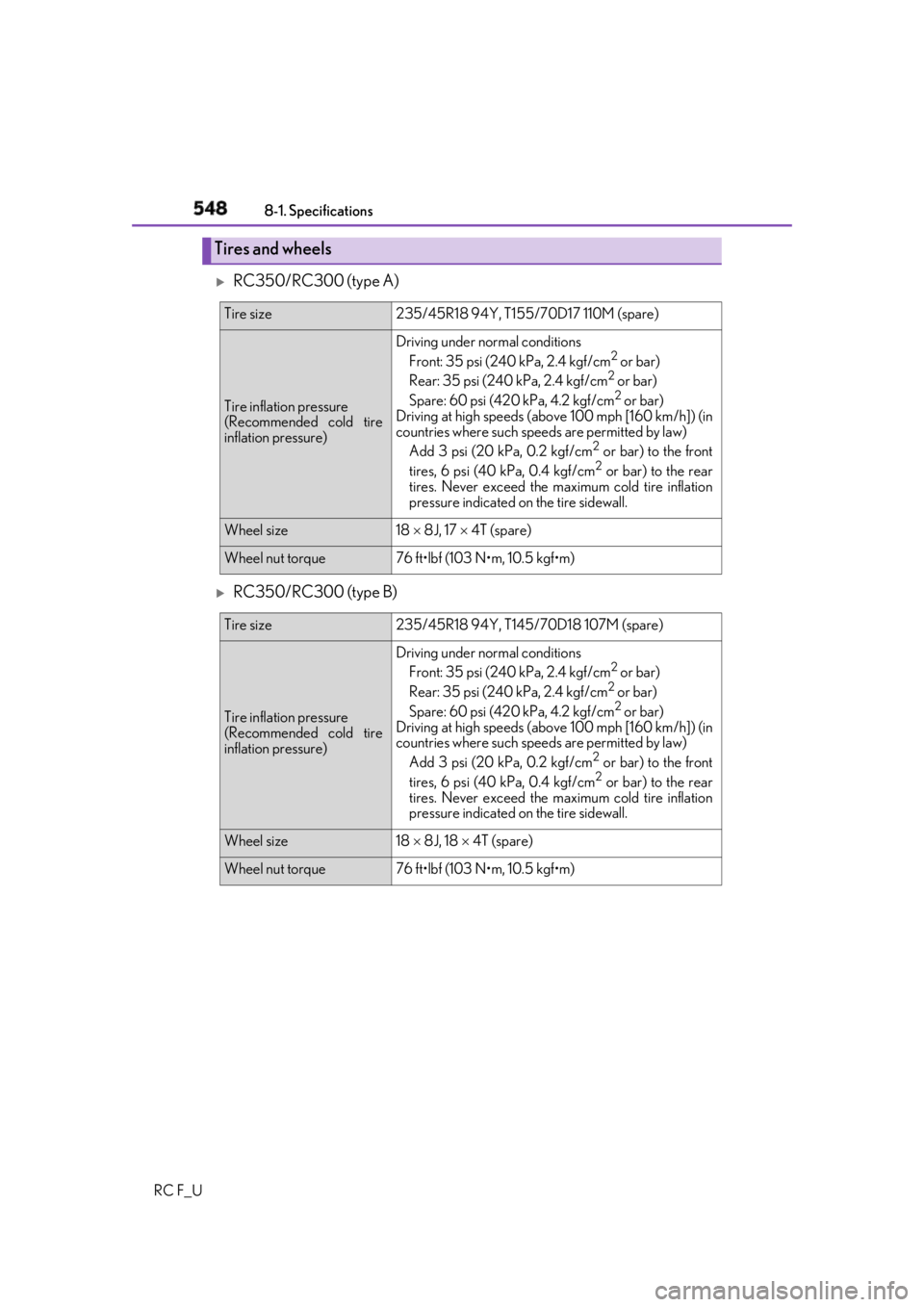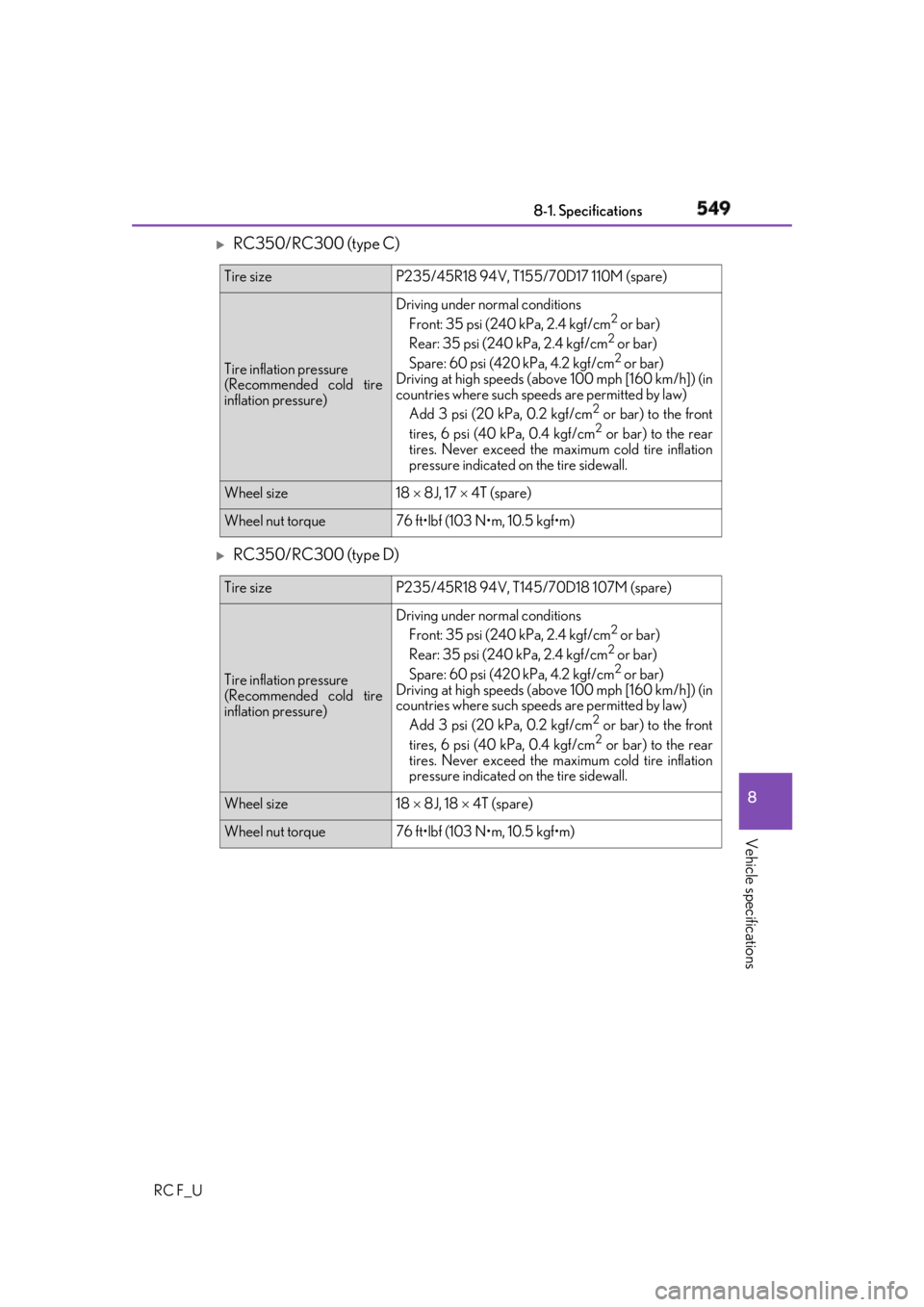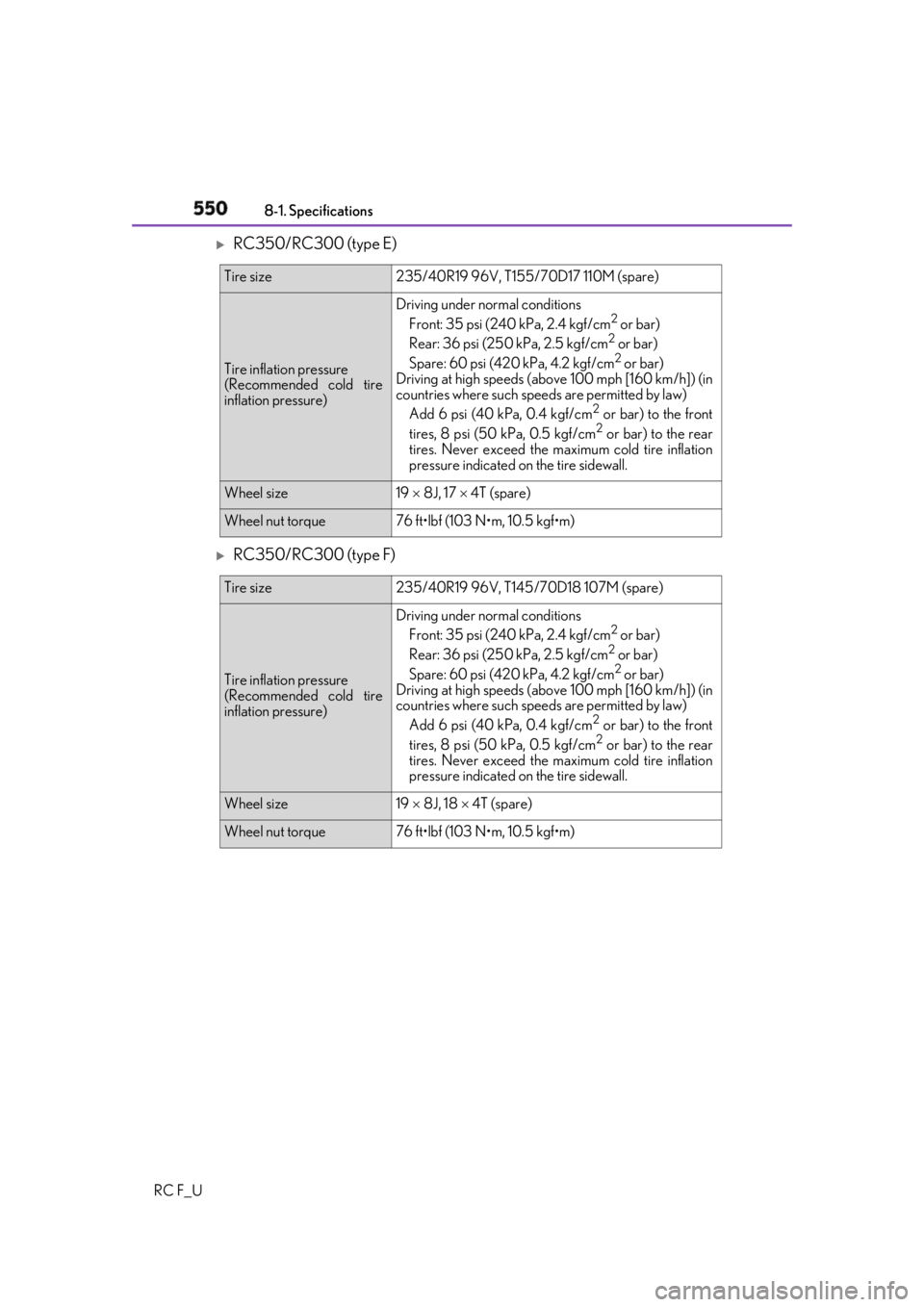2019 LEXUS RCF tire size
[x] Cancel search: tire sizePage 459 of 636

4597-2. Steps to take in an emergency
RC F_U 7
When trouble arises WARNING ■
Maintenance of the tires
Each tire, including the spare (if provided), should be checked monthly when cold and
inflated to the inflation pressure recomm ended by the vehicle manufacturer on the
vehicle placard or tire inflation pressure label (tire and load information label). (If your
vehicle has tires of a different size than the size indicated on the vehicle placard or tire
inflation pressure label [tire and load in formation label], you should determine the
proper tire inflation pressure for those tires.)
As an added safety feature, your vehicle ha s been equipped with a tire pressure moni-
toring system (TPMS-tire pressure warning system) that illuminates a low tire pressure
telltale (tire pressure warning light) when on e or more of your tires is significantly
under-inflated. Accordingly, when the low ti re pressure telltale (tire pressure warning
light) illuminates, you should st op and check your tires as soon as possible, and inflate
them to the proper pressure. Driving on a si gnificantly under-inflat ed tire causes the
tire to overheat and can lead to tire failure . Under-inflation also reduces fuel efficiency
and tire tread life, and may affect the vehicle’s handling and stopping ability.
Please note that the TPMS (tire pressure wa rning system) is not a substitute for proper
tire maintenance, and it is th e driver’s responsibility to ma intain correct tire pressure,
even if under-inflation has not reached the le vel to trigger illumina tion of the TPMS low
tire pressure telltale (tir e pressure warning light).
Your vehicle has also been equipped with a TPMS (tire pressure warning system) mal-
function indicator to indicate when the system is not operating properly. The TPMS
(tire pressure warning system) malfunction indi cator is combined with the low tire pres-
sure telltale (tire pressure warning light). When the system detects a malfunction, the
telltale will flash for approximately one mi nute and then remain continuously illumi-
nated. This sequence will cont inue upon subsequent vehicl e start-ups as long as the
malfunction exists. When the malfunction in dicator is illuminated, the system may not
be able to detect or signal low tire pressure as intended.
TPMS (tire pressure warning system) malfun ctions may occur for a variety of reasons,
including the installation of replacement or alternate tires or wheels on the vehicle that
prevent the TPMS (tire pressure warning system) from functioning properly. Always
check the TPMS (tire pressure warning system) malfunction telltale after replacing one
or more tires or wheels on your vehicle to ensure that the replacement or alternate
tires and wheels allow the TPMS (tire pressu re warning system) to continue to function
properly.
NOTICE ■
To ensure the tire pressure warning system operates properly
Do not install tires with different specificatio ns or makers, as the tire pressure warning
system may not operate properly.
Page 500 of 636

500 7-2. Steps to take in an emergency
RC F_U Firmly tighten each wheel nut two or
three times in the order shown in the
illustration. Tightening torque:
76 ft•lbf (103 N•m, 10.5 kgf•m)
Stow the flat tire, tire jack and all tools. ■
The spare tire ●
RC350/RC300:
The spare tire is identified by the label “TEMPORARY USE ONLY” on the tire sidewall.●
Use the spare tire temporarily , and only in an emergency.●
Make sure to check the tire inflat ion pressure of the spare tire. ( P. 548)■
When using the spare tire
As the spare tire is not equipped with a tire pressure warning valv e and transmitter, low
inflation pressure of the spare tire will not be indicated by the tire pressure warning sys-
tem. Also, if you replace the spare tire after the tire pressure warn ing light comes on, the
light remains on. ■
When the spare tire is equipped
The vehicle becomes lower when driving with the spare tire compared to when driving
with standard tires. ■
If you have a flat rear tire on a road covered with snow or ice (vehicles with front and
rear tires of the same size except fo r vehicles with LDH and 19-inch tires)
Install the spare tire on one of the front whee ls of the vehicle. Perform the following steps
and fit tire chains to the rear tires:
Replace a front tire with the spare tire.
Replace the flat rear tire with the tire removed from the front of the vehicle.
Fit tire chains to the rear tires. 4
5
1
2
3
Page 512 of 636

512 7-2. Steps to take in an emergency
RC F_U ■
Emergency tire puncture repair kit ●
The sealant has a limited lifespan. The expiry date is marked on the bottle. The sealant
should be replaced before the expiry date. Contact your Lexus dealer for replacement.●
The sealant stored in the emergency tire puncture repair kit can be used only once to
temporarily repair a single tire. If the seal ant has been used and needs to be purchased,
contact your Lexus dealer. The compressor is reusable.●
The sealant can be used when the outside temperature is from -40 F (-40 C) to
140 F (60 C).●
The kit is exclusively designed for size and type of tires originally in stalled on your vehi-
cle. Do not use it for tires that a different size than the original ones, or for any other
purposes. ●
If the sealant gets on yo ur clothes, it may stain.●
If the sealant adheres to a wheel or the surface of the vehicle body, the stain may not be
removable if it is not cleaned at once. Immediately wipe away the sealant with a wet
cloth. ●
During operation of the kit, a loud operation noise is produc ed. This does not indicate a
malfunction. ●
Do not use the emergency tire puncture repair kit to check or to adjust the tire pres-
sure.
Page 513 of 636

5137-2. Steps to take in an emergency
RC F_U 7
When trouble arises ■
If the tire is inflated to mo re than the recommended level
Disconnect the hose from the valve.
Disconnect the hose from the valve, remove the air releas e cap from the hose and then
reconnect the hose.
Turn the compressor switch on and wait for se veral seconds, then turn it off. Check that
the air pressure indicator sh ows the recommended level. ( P. 548)
If the air pressure is lower than the reco mmended level, turn th e compressor switch on
again and repeat the inflation procedure un til the recommended pr essure is reached.■
After a tire is repaired with the emergency tire puncture repair kit ●
The tire pressure warning valve an d transmitter should be replaced.●
Even if the tire inflation pres sure is at the recommended leve l, the tire pressure warning
light may come on/flash. ■
Note for checking the emergency tire puncture repair kit
Check the sealant expi ry date occasionally.
The expiry date is shown on the bottle. Do not use sealant whose expiry date has already
passed. Otherwise, repairs co nducted using the emergency ti re puncture repair kit may
not be performed properly. Install the air release cap to the end of the
hose and push the protrusion on the air
release cap into the valve to let some air out.
WARNING ■
Caution while driving
Observe the following precautions.
Failure to do so may cause an accident. ●
The emergency tire puncture repair kit is made exclusively for your vehicle. Do not
use it on other vehicles. ●
Do not use the emergency tire puncture repa ir kit for tires that are a different size
than the specified ones or for any other pu rpose. Doing so may cause the tires to not
be repaired properly. ■
Precautions for use of the sealant ●
Ingesting the sealant is hazardous to your health. If you ingest sealant, consume as
much water as possible, then immediately consult a doctor. ●
If sealant gets in eyes or adheres to skin, immediately wash it off with water. If discom-
fort persists, consult a doctor. 1
2
3
4
Page 548 of 636

548 8-1. Specifications
RC F_U
RC350/RC300 (type A)
RC350/RC300 (type B)Tires and wheels Tire size 235/45R18 94Y, T155/70D17 110M (spare)
Tire inflation pressure
(Recommended cold tire
inflation pressure) Driving under normal conditions
Front: 35 psi (240 kPa, 2.4 kgf/cm 2
or bar)
Rear: 35 psi (240 kPa, 2.4 kgf/cm 2
or bar)
Spare: 60 psi (420 kPa, 4.2 kgf/cm 2
or bar)
Driving at high speeds (above 100 mph [160 km/h]) (in
countries where such speeds are permitted by law)
Add 3 psi (20 kPa, 0.2 kgf/cm 2
or bar) to the front
tires, 6 psi (40 kPa, 0.4 kgf/cm 2
or bar) to the rear
tires. Never exceed the maximum cold tire inflation
pressure indicated on the tire sidewall.
Wheel size 18 8J, 17 4T (spare)
Wheel nut torque 76 ft •
lbf (103 N •
m, 10.5 kgf •
m)
Tire size 235/45R18 94Y, T145/70D18 107M (spare)
Tire inflation pressure
(Recommended cold tire
inflation pressure) Driving under normal conditions
Front: 35 psi (240 kPa, 2.4 kgf/cm 2
or bar)
Rear: 35 psi (240 kPa, 2.4 kgf/cm 2
or bar)
Spare: 60 psi (420 kPa, 4.2 kgf/cm 2
or bar)
Driving at high speeds (above 100 mph [160 km/h]) (in
countries where such speeds are permitted by law)
Add 3 psi (20 kPa, 0.2 kgf/cm 2
or bar) to the front
tires, 6 psi (40 kPa, 0.4 kgf/cm 2
or bar) to the rear
tires. Never exceed the maximum cold tire inflation
pressure indicated on the tire sidewall.
Wheel size 18 8J, 18 4T (spare)
Wheel nut torque 76 ft •
lbf (103 N •
m, 10.5 kgf •
m)
Page 549 of 636

5498-1. Specifications
8
Vehicle specifications
RC F_U
RC350/RC300 (type C)
RC350/RC300 (type D) Tire size P235/45R18 94V, T155/70D17 110M (spare)
Tire inflation pressure
(Recommended cold tire
inflation pressure) Driving under normal conditions
Front: 35 psi (240 kPa, 2.4 kgf/cm 2
or bar)
Rear: 35 psi (240 kPa, 2.4 kgf/cm 2
or bar)
Spare: 60 psi (420 kPa, 4.2 kgf/cm 2
or bar)
Driving at high speeds (above 100 mph [160 km/h]) (in
countries where such speeds are permitted by law)
Add 3 psi (20 kPa, 0.2 kgf/cm 2
or bar) to the front
tires, 6 psi (40 kPa, 0.4 kgf/cm 2
or bar) to the rear
tires. Never exceed the maximum cold tire inflation
pressure indicated on the tire sidewall.
Wheel size 18 8J, 17 4T (spare)
Wheel nut torque 76 ft •
lbf (103 N •
m, 10.5 kgf •
m)
Tire size P235/45R18 94V, T145/70D18 107M (spare)
Tire inflation pressure
(Recommended cold tire
inflation pressure) Driving under normal conditions
Front: 35 psi (240 kPa, 2.4 kgf/cm 2
or bar)
Rear: 35 psi (240 kPa, 2.4 kgf/cm 2
or bar)
Spare: 60 psi (420 kPa, 4.2 kgf/cm 2
or bar)
Driving at high speeds (above 100 mph [160 km/h]) (in
countries where such speeds are permitted by law)
Add 3 psi (20 kPa, 0.2 kgf/cm 2
or bar) to the front
tires, 6 psi (40 kPa, 0.4 kgf/cm 2
or bar) to the rear
tires. Never exceed the maximum cold tire inflation
pressure indicated on the tire sidewall.
Wheel size 18 8J, 18 4T (spare)
Wheel nut torque 76 ft •
lbf (103 N •
m, 10.5 kgf •
m)
Page 550 of 636

550 8-1. Specifications
RC F_U
RC350/RC300 (type E)
RC350/RC300 (type F) Tire size 235/40R19 96V, T155/70D17 110M (spare)
Tire inflation pressure
(Recommended cold tire
inflation pressure) Driving under normal conditions
Front: 35 psi (240 kPa, 2.4 kgf/cm 2
or bar)
Rear: 36 psi (250 kPa, 2.5 kgf/cm 2
or bar)
Spare: 60 psi (420 kPa, 4.2 kgf/cm 2
or bar)
Driving at high speeds (above 100 mph [160 km/h]) (in
countries where such speeds are permitted by law)
Add 6 psi (40 kPa, 0.4 kgf/cm 2
or bar) to the front
tires, 8 psi (50 kPa, 0.5 kgf/cm 2
or bar) to the rear
tires. Never exceed the maximum cold tire inflation
pressure indicated on the tire sidewall.
Wheel size 19 8J, 17 4T (spare)
Wheel nut torque 76 ft •
lbf (103 N •
m, 10.5 kgf •
m)
Tire size 235/40R19 96V, T145/70D18 107M (spare)
Tire inflation pressure
(Recommended cold tire
inflation pressure) Driving under normal conditions
Front: 35 psi (240 kPa, 2.4 kgf/cm 2
or bar)
Rear: 36 psi (250 kPa, 2.5 kgf/cm 2
or bar)
Spare: 60 psi (420 kPa, 4.2 kgf/cm 2
or bar)
Driving at high speeds (above 100 mph [160 km/h]) (in
countries where such speeds are permitted by law)
Add 6 psi (40 kPa, 0.4 kgf/cm 2
or bar) to the front
tires, 8 psi (50 kPa, 0.5 kgf/cm 2
or bar) to the rear
tires. Never exceed the maximum cold tire inflation
pressure indicated on the tire sidewall.
Wheel size 19 8J, 18 4T (spare)
Wheel nut torque 76 ft •
lbf (103 N •
m, 10.5 kgf •
m)
Page 551 of 636

5518-1. Specifications
8
Vehicle specifications
RC F_U
RC350/RC300 (type G)
RC350/RC300 (type H) Tire size Front tires: 235/40R19 96Y XL
Rear tires: 265/35R19 94Y
Spare tire: T155/70D17 110M
Tire inflation pressure
(Recommended cold tire
inflation pressure) Driving under normal conditions
Front: 35 psi (240 kPa, 2.4 kgf/cm 2
or bar)
Rear: 36 psi (250 kPa, 2.5 kgf/cm 2
or bar)
Spare: 60 psi (420 kPa, 4.2 kgf/cm 2
or bar)
Driving at high speeds (above 100 mph [160 km/h]) (in
countries where such speeds are permitted by law)
Add 6 psi (40 kPa, 0.4 kgf/cm 2
or bar) to the front
tires. Never exceed the maximum cold tire inflation
pressure indicated on the tire sidewall.
Wheel size Front wheels: 19 8J
Rear wheels: 19 9J
Spare wheel: 17 4T
Wheel nut torque 76 ft •
lbf (103 N •
m, 10.5 kgf •
m)
Tire size Front tires: 235/40R19 96Y XL
Rear tires: 265/35R19 94Y
Spare tire: T145/70D18 107M
Tire inflation pressure
(Recommended cold tire
inflation pressure) Driving under normal conditions
Front: 35 psi (240 kPa, 2.4 kgf/cm 2
or bar)
Rear: 36 psi (250 kPa, 2.5 kgf/cm 2
or bar)
Spare: 60 psi (420 kPa, 4.2 kgf/cm 2
or bar)
Driving at high speeds (above 100 mph [160 km/h]) (in
countries where such speeds are permitted by law)
Add 6 psi (40 kPa, 0.4 kgf/cm 2
or bar) to the front
tires. Never exceed the maximum cold tire inflation
pressure indicated on the tire sidewall.
Wheel size Front wheels: 19 8J
Rear wheels: 19 9J
Spare wheel: 18 4T
Wheel nut torque 76 ft •
lbf (103 N •
m, 10.5 kgf •
m)